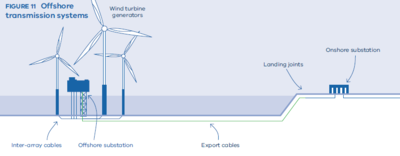Knowledge fuels change
For over a decade, Energypedia has shared free, reliable energy expertise with the world.
We’re now facing a serious funding gap.
Help keep this platform alive — your donation, big or small, truly matters!
Thank you for your support
Transmission Infrastructure
Introduction
In an electricity grid, power needs to be transmitted from where it is generated to where it is used.
This requires the development of transmission infrastructure encompassing the physical equipment and systems used for the transmission of electric power at high voltages over long distances. In substations, the electricity is then reduced to lower voltages for distribution and utilisation by private, public, and industrial customers. Transmission infrastructure includes, i.e., power lines, poles, lines, towers, converters, transformers and substations.[1] [2][3]
Conventional power grids, which produce electricity in large quantities and deliver it in a one-way direction to different users, are facing the challenge of integrating an increasing share of distributed and often intermittent renewable energy sources. It is therefore necessary for them to become more efficient and intelligent (i.e. 'smart').[1]
Transmission Infrastructure Types
There is a range of different transmission types with different characteristics, including:
- construction methods
- operation and maintenance needs
- environmental and land use impacts
Onshore Transmission Infrastructure
Transmission infrastructure can be deployed in two main ways: as overhead lines, which consist of conductors suspended on poles or towers and which carry high-voltage electricity from power plants to substations and homes; and as underground cables, which are mostly used in urban areas.[1]
Offshore Transmission Infrastructure
An offshore transmission system is a network of (subsea) cables that connect offshore turbines to offshore and onshore substations. Subsequently, the substations are connected to the existing energy grid.[1]
Energy Losses
The transmission of electricity over significant distances results in the loss of energy, from overhead lines and conductors, transformers and power cables. There are three main reasons for this:[4]
- The Joule effect: energy is lost as heat in the conductor (a copper wire, for instance)
- Magnetic loss: energy dissipates in metallic parts penetrated by magnetic fields
- The dielectric effect: energy is absorbed by the insulating material
Further Information
- Grid Portal on energypedia
References
- ↑ 1.0 1.1 1.2 1.3 International Electronic Commission: Transmission and distribution of electricity; retrieved October 2024
- ↑ https://www.lawinsider.com/dictionary/transmission-infrastructure
- ↑ The State of Victoria Department of Energy, Environment and Climate Action 2023, Summary of transmission infrastructure
- ↑ International Electrotechnical Commission (2018): Transmission and distribution.






















